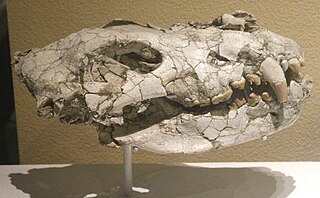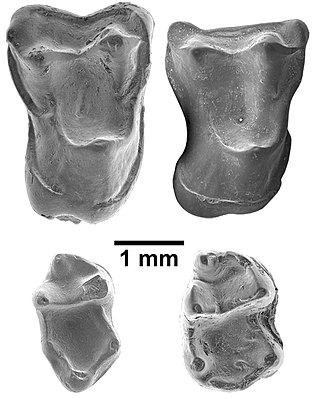
Barbourofelidae is an extinct family of carnivorans of the suborder Feliformia, sometimes known as false saber-toothed cats, that lived in North America, Eurasia and Africa during the Miocene epoch and existed for about 7.9 million years. Thought to be an independent lineage from the Nimravidae and Machairodontinae, which had all attained elongated canines, recent research argues that it may be a subfamily of the Nimravidae, extending its biochronological range into the Miocene, although this issue is not yet fully resolved.

Gobicyon is an extinct genus of large-sized carnivoran mammals, belonging to the Amphicyonidae, that was discovered in China, Mongolia, and Serbia, and lived during the Middle Miocene epoch. Despite only being known from rather fragmentary remains, recent discoveries showcase that it was an aberrant member of the subfamily Haplocyoninae, with adaptions towards bone-crushing similar to those of a hyaena.

Triaenops goodmani is an extinct bat from Madagascar in the genus Triaenops. It is known from three lower jaws collected in a cave at Anjohibe in 1996, and described as a new species in 2007. The material is at most 10,000 years old. A bat humerus from the same site could not be identified as either T. goodmani or the living T. menamena. T. goodmani is identifiable as a member of Triaenops or the related genus Paratriaenops by a number of features of the teeth, such as the single-cusped, canine-like fourth premolar and the presence of a gap between the entoconid and hypoconulid cusps on the first two molars. T. goodmani is larger than the living species of Triaenops and Paratriaenops on Madagascar, and on the first molar the protoconid cusp is only slightly higher than the hypoconid, not much higher as in the other species.
Galerix kostakii is a fossil erinaceid mammal from the early Miocene of Greece. It is known from the site of Karydia, assigned to the biostratigraphical zone MN 4; similar fossils have been found at an approximately contemporary Czech site and a slightly younger Greek site. With characters like the presence of a hypocone on the upper third premolar, the presence of a connection between the protocone and metaconule cusps on the second upper molar in only a few specimens, this species is intermediate between the slightly older Galerix symeonidisi and the slightly younger Parasorex pristinus. It may form part of the lineage leading from the genus Galerix to the younger genus Parasorex.
Dermotherium is a genus of fossil mammals closely related to the living colugos, a small group of gliding mammals from Southeast Asia. Two species are recognized: D. major from the Late Eocene of Thailand, based on a single fragment of the lower jaw, and D. chimaera from the Late Oligocene of Thailand, known from three fragments of the lower jaw and two isolated upper molars. In addition, a single isolated upper molar from the Early Oligocene of Pakistan has been tentatively assigned to D. chimaera. All sites where fossils of Dermotherium have been found were probably forested environments and the fossil species were probably forest dwellers like living colugos, but whether they had the gliding adaptations of the living species is unknown.

Afrasia djijidae is a fossil primate that lived in Myanmar approximately 37 million years ago, during the late middle Eocene. The only species in the genus Afrasia, it was a small primate, estimated to weigh around 100 grams (3.5 oz). Despite the significant geographic distance between them, Afrasia is thought to be closely related to Afrotarsius, an enigmatic fossil found in Libya and Egypt that dates to 38–39 million years ago. If this relationship is correct, it suggests that early simians dispersed from Asia to Africa during the middle Eocene and would add further support to the hypothesis that the first simians evolved in Asia, not Africa. Neither Afrasia nor Afrotarsius, which together form the family Afrotarsiidae, is considered ancestral to living simians, but they are part of a side branch or stem group known as eosimiiforms. Because they did not give rise to the stem simians that are known from the same deposits in Africa, early Asian simians are thought to have dispersed from Asia to Africa more than once prior to the late middle Eocene. Such dispersals from Asia to Africa also were seen around the same time in other mammalian groups, including hystricognathous rodents and anthracotheres.
Indraloris is a fossil primate from the Miocene of India and Pakistan in the family Sivaladapidae. Two species are now recognized: I. himalayensis from Haritalyangar, India and I. kamlialensis from the Pothohar Plateau, Pakistan. Other material from the Potwar Plateau may represent an additional, unnamed species. Body mass estimates range from about 2 kg (4.4 lb) for the smaller I. kamlialensis to over 4 kg (8.8 lb) for the larger I. himalayensis.
Sivaladapis is a genus of adapiform primate that lived in Asia during the middle Miocene.
Exiguodon is an extinct genus of hyainailourid hyaenodont mammal of the subfamily Hyainailourinae. Remains are known from early Miocene deposits in Kenya and Uganda, in East Africa.
Sectisodon is an extinct genus of hyainailourid hyaenodont mammal of the subfamily Hyainailourinae from early Oligocene to early Miocene deposits in Egypt and Uganda.
Miopanthera is an extinct genus of Pseudaelurus-grade felids.
Asilifelis is an extinct genus of small felid that lived in what is now Kenya during the Early Miocene. Despite its fragmentary remains, it is remarkable because of its small size and advanced dentition. It contains a single species, Asilifelis cotae.
Diamantofelis is an extinct genus of felids that lived in what is now Namibia during the Early Miocene. It contains a single species, Diamantofelis ferox.
Namafelis is an extinct genus of felids that lived in what is now Namibia during the Early Miocene. It contains a single species, Namafelis minor. Closely related to Diamantofelis, it is of “Pseudaelurus-grade”, and therefore a rather basal member of the cat family.
Myacyon is an extinct genus of large sized carnivoran mammals, belonging to the family Amphicyonidae, that lived in Africa during the Miocene epoch. Due to the limited scope and fragmentary nature of the severely damaged holotype, as well as the illustrations in its descriptions, which have been called inadequate, usage of this genus poses serious issues. However, it is notable for being one of the last surviving members of its family and its adaptions to hypercarnivory. Its relationships to other amphicyonids are obscure, and it is not closely related to Bonisicyon, the other late surviving African genus, although it has been proposed that it descends from a species of Cynelos or Namibiocyon.
Bonisicyon is an extinct genus of carnivoran mammals, belonging to the family Amphicyonidae. It is the last-surviving member of its family, living in East Africa during the end of the Miocene epoch. Known only from a damaged mandible and isolated teeth from the Nawata Formation, and possibly also the Lukeino Formation, its closer taxonomic affinities are unclear. It is notable for both its small size, and its unique dentition.
Namibiocyon is an extinct genus of carnivoran mammals, belonging to the family Amphicyonidae, that lived in Namibia during the Early Miocene epoch. Before the erection of this taxon in 2022, the type and only species, N. ginsburgi, had been assigned to a variety of other genera. It is notable for its adaptions toward hypercarnivory.

Lonchocyon is an extinct genus of arctoid carnivorans, with possible affinities to amphicyonids or hemicyonine bears. It contains a single species, Lonchocyon qiui, known from a single left mandible discovered at the fossil-bearing locality Haerhada at the base of the Baron Sog Formation, which is located in Inner Mongolia, China, and dates to the late Eocene. This taxon is notable for its large size in comparison to other arctoid carnivorans of the Eocene epoch, and for its hypercarnivorous adaptions, most notably its large canine and strongly reduced premolars. The genus name is a combination of Greek lonch, meaning spear and referencing the spear-like paraconid on its lower carnassial, and cyon, meaning dog. The specific name honours Professor Zhan-Xiang Qiu.
Alagtsavbaatar is an extinct species of carnivorous cat-like carnivoran belonging to the infraorder Aeluroidea. It was endemic to Asia, with all known specimens being found in Mongolia, and lived during the late Eocene epoch. It is a monotypic genus, with the type and only known species being A. indigenus, and is named after the Alag Tsav locality where its remains were first discovered.
Peignecyon is an extinct genus of large carnivorans belonging to the family Amphicyonidae. It belongs to the subfamily Thaumastocyoninae, which is characterized by their adaptions towards hypercarnivory. Whereas most other thaumastocyonines are often only known from fragmentary remains and isolated teeth, Peignecyon is known from a variety of well-preserved remains. It contains a single species, P. felinoides from the Early Miocene of the Czech Republic.




